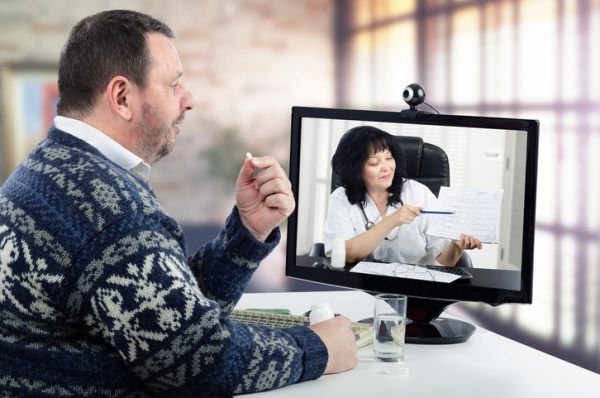
I’ve worked in the healthcare field for decades. As I reflect on the recent crisis my colleagues and I (and the world) are faced with, it’s no secret that we have been skyrocketed forward in how we must now access healthcare — patients and providers alike.
As a direct result of Covid-19, telemedicine has experienced explosive growth. As people grow fearful of venturing out into public with germs and viruses, doctors and patients are realizing that telehealth, which is hardly a new concept, is not as difficult a transition as they thought it would be. In reality, virtually connecting with patients can save providers time and money if they are able to use a platform that can encompass all of the tools needed to run their entire practice from the inside of their homes.

Health Benefit Consultants, Share Your Expert Insights in Our Survey
Clint Phillips Clinton Phillips is currently the founder and CEO of Medici, a global healthcare communication platform. Medici has raised over $40m dollars, has acquired DocBookMD and Chiron Health and now has over 20,000 doctors communicating on its platform monthly. In 2005, Phillips created the Aspen Back Institute at the St. Regis. Backed by the […]
The big difference in how telemedicine is being used now, compared to in the past, is that providers use it intentionally and can bill for it, and patients are seeking it out. Before this global pandemic, telemedicine was a nice-to-have but now it’s a necessity.
Several years ago, practices used telemedicine as a way to diagnose thousands of patients’ spine conditions. Patients would fill out web forms or call directly requesting a review of their spine MRI which was all done by phone and/or email. With a confirmed diagnosis by telemedicine, patients would travel to the nearest spine center for a procedure.
In my opinion, there are three ways you can approach telemedicine moving forward:
The first is for providers to use existing tools such as FaceTime, Skype and Zoom to conduct virtual consults with their patients. This poses a myriad of issues related to privacy since these services are not required to be HIPAA-compliant, and the doctor has to physically write down and record everything from the visit to then input the information into that particular patient’s medical record or EMR.

A Deep-dive Into Specialty Pharma
A specialty drug is a class of prescription medications used to treat complex, chronic or rare medical conditions. Although this classification was originally intended to define the treatment of rare, also termed “orphan” diseases, affecting fewer than 200,000 people in the US, more recently, specialty drugs have emerged as the cornerstone of treatment for chronic and complex diseases such as cancer, autoimmune conditions, diabetes, hepatitis C, and HIV/AIDS.
The second way to approach telemedicine is using a ‘call center’ type platform that will virtually connect patients with a provider that they’ve never met before and will probably never speak to again after their visit. These visits are problematic as providers don’t know the patient’s medical history and are relying on that patient’s (often unreliable) personal recollection of medications taken in the past and previous health issues. Call center doctors are making diagnoses based on a very surface level conversation without really knowing a patient’s full medical background.
The third, and in my opinion most effective, way to have a mutually productive and beneficial virtual visit is through a platform that will allow patients to connect with their own provider. A platform that is HIPAA-compliant and can be easily downloaded by a provider that has a pre-existing relationship with the patient is the optimal way to have an accurate, effective and positive telemedicine visit. Additionally, providers and patients should be utilizing a platform that saves data recorded from each visit, and automatically uploads that information into the patient’s EMR and the provider’s system, minimizing the risk of lost files, patient histories and saving both parties precious time.
Covid-19 has pushed the industry into testing the healthcare at home model where the future will allow patients better and safer access to care, moving away from hospitals and going somewhere to see a doctor. For physicians and medical staff, they will become more nimble. There will most likely be some consolidation in the telemedicine space and a lot of diagnostic devices developed for at-home use.
Photo: verbaska_studio, Getty Images
Clinton Phillips is currently the founder and CEO of Medici, a global healthcare communication platform. Medici has raised over $40m dollars, has acquired DocBookMD and Chiron Health and now has over 20,000 doctors communicating on its platform monthly.
In 2005, Phillips created the Aspen Back Institute at the St. Regis. Backed by the acclaimed founder of Starwood Hotels, Barry Sternlicht, Aspen Back became a global destination for people from over 40 countries and helped over 1,900 people avoid spine surgery.
Prior to Medici, Phillips created 2nd.MD in 2011 after his daughter suffered a stroke and was left paralyzed. 2nd.MD is a virtual 2nd opinion platform that provides video access to the world’s best doctors at the top 17 US hospitals. 2nd.MD now does more virtual 2nd opinions than the top hospitals combined and has over 10million members. 2nd.MD’s clients include Morgan Stanley, KPMG, EY, United Healthcare, Aetna, Bloomberg, Waste Management and 30 other Fortune 100 companies.
In philanthropy, Phillips is recognized as the largest sponsor of orphans at World Vision and other organizations. In sports, Phillips is recognized as the US National Champion for the 400m and javelin by the USA Track & Field Masters. Phillips has enjoyed the opportunity to speak at Rice, MIT, Princeton and churches across the country and has been featured on CBS, ABC, Forbes, Tech Crunch, Robb Report and more.
Residing in Austin, Texas, Clint has three children with his wife Jade.











